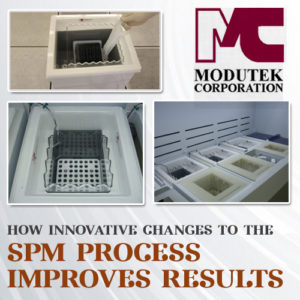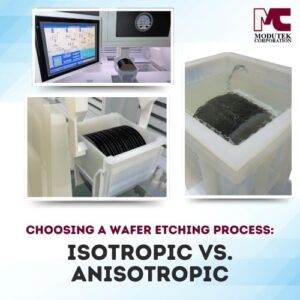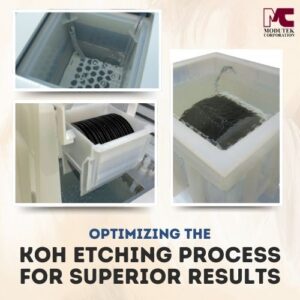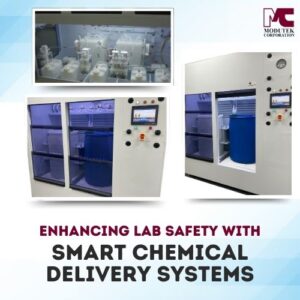 When the SPM process requires frequent spiking with hydrogen peroxide, precise control is difficult and the useful lifetime of the mixture is reduced. The SPM process, using a mixture of sulfuric acid and hydrogen peroxide, is a popular wafer cleaning process because it quickly removes large amounts of organic material from the surface of silicon wafers. It is ideally suited for stripping photoresist and it hydroxylates surfaces making them hydrophilic (having an affinity for water) in preparation for subsequent wafer processing steps. Spiking with hydrogen peroxide keeps the process going but it means the mixture has to be replaced about once a day. Modutek has developed an innovative way to control the process, resulting in significant cost savings and improved results.
When the SPM process requires frequent spiking with hydrogen peroxide, precise control is difficult and the useful lifetime of the mixture is reduced. The SPM process, using a mixture of sulfuric acid and hydrogen peroxide, is a popular wafer cleaning process because it quickly removes large amounts of organic material from the surface of silicon wafers. It is ideally suited for stripping photoresist and it hydroxylates surfaces making them hydrophilic (having an affinity for water) in preparation for subsequent wafer processing steps. Spiking with hydrogen peroxide keeps the process going but it means the mixture has to be replaced about once a day. Modutek has developed an innovative way to control the process, resulting in significant cost savings and improved results.
How the SPM Process Cleans Wafers
The mixture of sulfuric acid and hydrogen peroxide removes organic material very quickly because it is highly corrosive, but it is also unstable. The hydrogen peroxide decays to form water that reduces the mixture concentration and slows down cleaning. To keep the process going, the mixture is periodically spiked with hydrogen peroxide, bringing the concentration back up. At the same time, adding hydrogen peroxide to sulfuric acid is exothermic, raising the temperature of the mixture. Cleaning takes place more quickly at higher temperatures, but the hydrogen peroxide decays more quickly as well, influencing control accuracy. Repeated spiking limits the useful life of the mixture to about one day. Daily replacement of the chemicals is expensive and results in delays for the processing line.
“Bleed and Feed” Process Change Saves Money and Improves Output
Modutek has developed an innovative SPM control strategy that prolongs the life of the SPM mixture while precisely controlling mixture temperature and concentration. In the “bleed and feed” method, Modutek uses a two tank system with a clean tank and a dirty tank. Small programmable amounts are regularly drained from the dirty tank and replaced with mixture from the clean tank. To restore the mixture in both tanks, sulfuric acid is added to the clean tank to replace the amount drained and small amounts of hydrogen peroxide are added to both tanks to maintain the required concentration. This semi-continuous process keeps the mixture concentration within narrow limits without spiking and without the temperature changes caused by spiking.
The “bleed and feed” method is PLC-controlled and the amounts to be drained, the replacement amounts and the frequency of operation can all be adjusted for optimal process results. The concentration and temperature of the mixture remain within tight limits and the process control is more accurate. The useful life of the mixture can be extended to as much as a week and the more precise process control gives improved results.
Benefits from “Bleed and Feed” Process Change
Modutek’s “bleed and feed” method means that chemical use and disposal is reduced substantially. When the wafer cleaning process performance is precise and predictable, better repeatability and consistent cleaning times result in better process line performance. When mixture life is stretched from one day to a week, the cost of chemicals is greatly reduced while the process equipment can stay in service longer since it doesn’t have to be shut down as often for changing the mixture. Downtime is lower and throughput increases.
As a leading semiconductor equipment manufacturer, Modutek continues to work closely with customers to develop innovations that can improve process results. The “bleed and feed” control method increases productivity and reduces costs while the decreased use of chemicals is environmentally friendly. The new process control method could be of interest to manufacturing and research facility managers who can use it to lower production costs, improve output quality and decrease the plant’s environmental footprint. Modutek offers free consultation can discuss details on how the new SPM control method can improve the process for your application.




